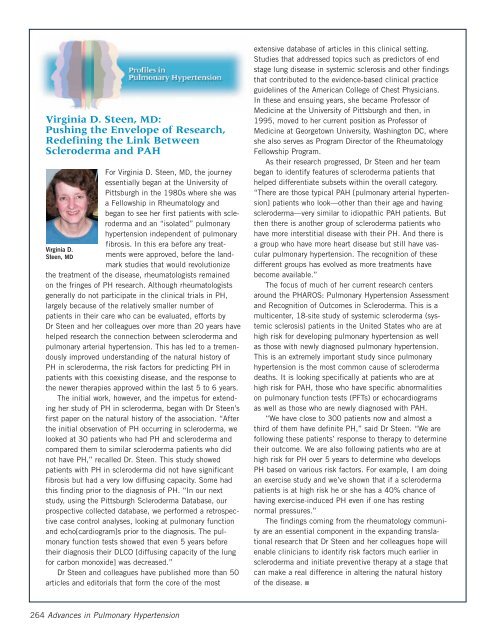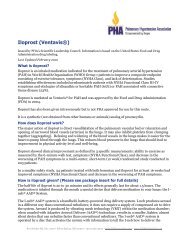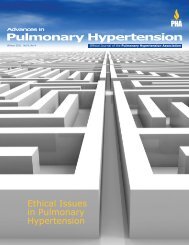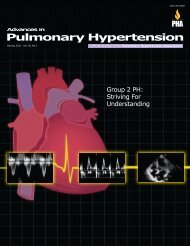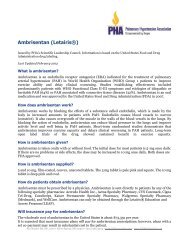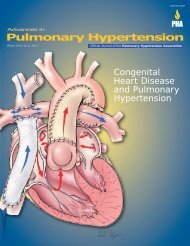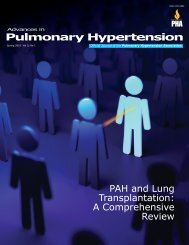Pulmonary Hypertension - PHA Online University
Pulmonary Hypertension - PHA Online University
Pulmonary Hypertension - PHA Online University
Create successful ePaper yourself
Turn your PDF publications into a flip-book with our unique Google optimized e-Paper software.
Virginia D. Steen, MD:Pushing the Envelope of Research,Redefining the Link BetweenScleroderma and PAHVirginia D.Steen, MDFor Virginia D. Steen, MD, the journeyessentially began at the <strong>University</strong> ofPittsburgh in the 1980s where she wasa Fellowship in Rheumatology andbegan to see her first patients with sclerodermaand an “isolated” pulmonaryhypertension independent of pulmonaryfibrosis. In this era before any treatmentswere approved, before the landmarkstudies that would revolutionizethe treatment of the disease, rheumatologists remainedon the fringes of PH research. Although rheumatologistsgenerally do not participate in the clinical trials in PH,largely because of the relatively smaller number ofpatients in their care who can be evaluated, efforts byDr Steen and her colleagues over more than 20 years havehelped research the connection between scleroderma andpulmonary arterial hypertension. This has led to a tremendouslyimproved understanding of the natural history ofPH in scleroderma, the risk factors for predicting PH inpatients with this coexisting disease, and the response tothe newer therapies approved within the last 5 to 6 years.The initial work, however, and the impetus for extendingher study of PH in scleroderma, began with Dr Steen’sfirst paper on the natural history of the association. “Afterthe initial observation of PH occurring in scleroderma, welooked at 30 patients who had PH and scleroderma andcompared them to similar scleroderma patients who didnot have PH,” recalled Dr. Steen. This study showedpatients with PH in scleroderma did not have significantfibrosis but had a very low diffusing capacity. Some hadthis finding prior to the diagnosis of PH. “In our nextstudy, using the Pittsburgh Scleroderma Database, ourprospective collected database, we performed a retrospectivecase control analyses, looking at pulmonary functionand echo[cardiogram]s prior to the diagnosis. The pulmonaryfunction tests showed that even 5 years beforetheir diagnosis their DLCO [diffusing capacity of the lungfor carbon monoxide] was decreased.”Dr Steen and colleagues have published more than 50articles and editorials that form the core of the mostextensive database of articles in this clinical setting.Studies that addressed topics such as predictors of endstage lung disease in systemic sclerosis and other findingsthat contributed to the evidence-based clinical practiceguidelines of the American College of Chest Physicians.In these and ensuing years, she became Professor ofMedicine at the <strong>University</strong> of Pittsburgh and then, in1995, moved to her current position as Professor ofMedicine at Georgetown <strong>University</strong>, Washington DC, whereshe also serves as Program Director of the RheumatologyFellowship Program.As their research progressed, Dr Steen and her teambegan to identify features of scleroderma patients thathelped differentiate subsets within the overall category.“There are those typical PAH [pulmonary arterial hypertension]patients who look—other than their age and havingscleroderma—very similar to idiopathic PAH patients. Butthen there is another group of scleroderma patients whohave more interstitial disease with their PH. And there isa group who have more heart disease but still have vascularpulmonary hypertension. The recognition of thesedifferent groups has evolved as more treatments havebecome available.”The focus of much of her current research centersaround the <strong>PHA</strong>ROS: <strong>Pulmonary</strong> <strong>Hypertension</strong> Assessmentand Recognition of Outcomes in Scleroderma. This is amulticenter, 18-site study of systemic scleroderma (systemicsclerosis) patients in the United States who are athigh risk for developing pulmonary hypertension as wellas those with newly diagnosed pulmonary hypertension.This is an extremely important study since pulmonaryhypertension is the most common cause of sclerodermadeaths. It is looking specifically at patients who are athigh risk for PAH, those who have specific abnormalitieson pulmonary function tests (PFTs) or echocardiogramsas well as those who are newly diagnosed with PAH.“We have close to 300 patients now and almost athird of them have definite PH,” said Dr Steen. “We arefollowing these patients’ response to therapy to determinetheir outcome. We are also following patients who are athigh risk for PH over 5 years to determine who developsPH based on various risk factors. For example, I am doingan exercise study and we’ve shown that if a sclerodermapatients is at high risk he or she has a 40% chance ofhaving exercise-induced PH even if one has restingnormal pressures.”The findings coming from the rheumatology communityare an essential component in the expanding translationalresearch that Dr Steen and her colleagues hope willenable clinicians to identify risk factors much earlier inscleroderma and initiate preventive therapy at a stage thatcan make a real difference in altering the natural historyof the disease. ■264 Advances in <strong>Pulmonary</strong> <strong>Hypertension</strong>


